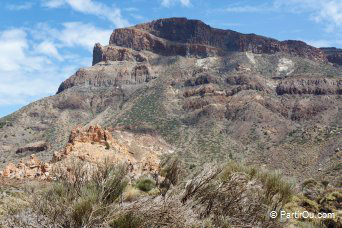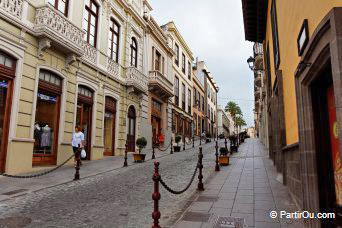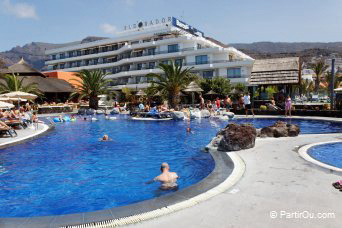Located in the Atlantic Ocean, west of Morocco, the Canary Islands form an archipelago of 7 main islands surrounded by less large islands. The 4 most touristically known islands are the islands Tenerife, Fuerteventura, Lanzarote and Gran Canaria, the least known are La Gomera, La Palma and El Hierro. The Canary archipelago is part of Spain and the main islands are inhabited. Despite their proximity to each other, these beautiful islands have very specific characteristics. The Canary Islands are of volcanic origin, the traces of this geology can be seen on each of them and particularly on the islands Lanzarote and Tenerife. The Canary Islands are known for their mild climate throughout the year.
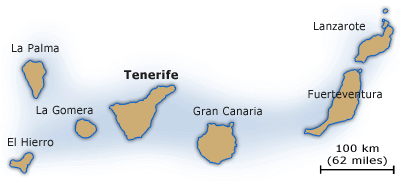
Tenerife is the largest of the Canary Islands and also the most visited. It offers sometimes wild coastline, sometimes lined with resorts and volcanic landscapes of outstanding beauty!
What to do on Tenerife Island?
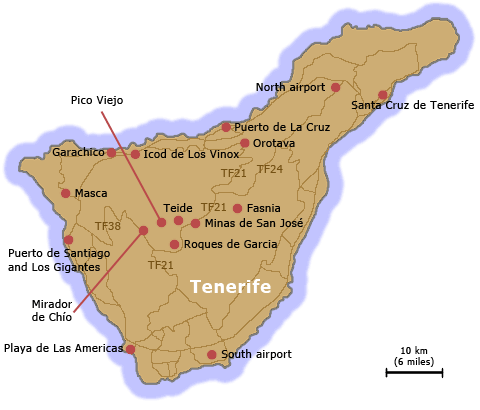
You are a fan of sunbathing on the beach or rather eager to walk in the mountains? On Tenerife everyone will find something to occupy his time according to his tastes!
Beaches and rest
The beaches of the island Tenerife are usually covered with black sand. Enjoy the beaches is certainly the main activity of tourists. Swimming in the sea is possible throughout the year, although the water temperature may be cold in February (about 18°C (64°F)) and moderately warm in September (maximum 25°C (77°F)). The beaches and resorts are plenty and are very well organized to welcome tourists. Alongside the sea bathing, tourists can enjoy the swimming pool of their hotel. The most popular resorts are on Playa de Las Americas, Costa Adeje, Puerto de la Cruz and Puerto de Santiago.
Walks and mountain hikes
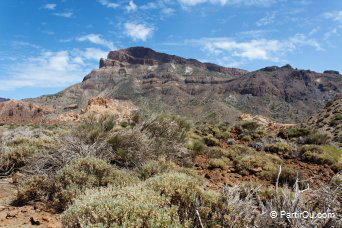
Tenerife has a spectacular landscape. The island can be fully and easily browse by car (car rental is very cheap).
Hiking routes are numerous and well marked. They allow to discover an incredible fauna and flora. According to the altitude, the landscape can be very different. For example, at an average altitude, the landscape is very green with large pine forests (pine or Pinus canariensis Canary). Hiking further up allow to discover a breathtaking and arid volcanic landscape. The island of Tenerife holds the altitude record of Canary Islands with the "Teide" which rises to 3718 meters! The peak of Teide is available partly by road and by hiking or by taking a cable car.
Teide National Park
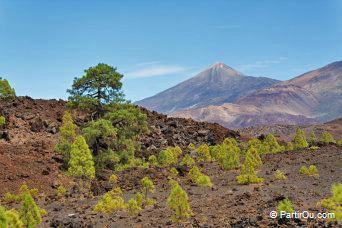
The TF21 road (or C821) crosses the island from north to south and pass close
to the Teide peak. The TF38 road (or C823) and TF24 (or C824) also can reach the
Teide. These beautiful roads leading to the heart of the Teide National Park
(also called National Park of Las Cañadas del Teide) are not to be missed!
(
Mount Teide
Culmination point of the Canary Islands, this magnificent volcanic cone rises to 3718 meters above sea level! The TF21 road, parking (which is about 2360 meters above sea level) is located near the cable car to get closer to the top. The Teide cable car can reach in few minutes 3555 meters high. At the finish, it is possible to make trips of different difficulty levels and this, for several kilometers.
At 3555 m, it remains to perform 163 vertical meters to the summit (3718 m). The path that achieves the latter is called "Telesforo Bravo, No. 10" ; it's practicable subject to authorization. Indeed, a license must first be asked to the management of the National Park (booking to do here, then choose "Teide"). From above, a magnificent 360° view allows to observe Tenerife and all other surrounding islands (and also Gran Canaria). It also shows some fumaroles that emit an unpleasant smell of sulfur and some yellow traces corresponding to sulfur deposit.
To complete ascent of Mount Teide without taking the cable car, several paths can be borrowed. A trail starts at the viewpoint "Mirador de Chío" to 2050 meters high; the route passes through the crater the Narices del Teide and Pico Viejo before joining the Teide. Another trail starts at the parking "Montaña Blanca" located about 2350 meters high. All paths converge at the cable car at 3555 meters. Do not underestimate the difficulty of the hikes and do not lose in mind that we are in the mountains.
Roques de Garcia
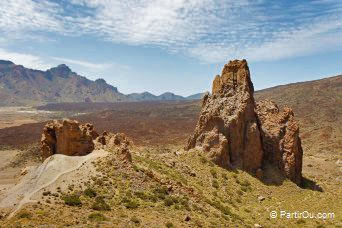
Also located in the Teide National Park, the impressive rocks called Roques de Garcia are worth to be seen! Parking slot permit to approach, but the ideal to observe, is to undertake a short walk of about 1 hour. A path can even go around, but it is classified as "difficult" and takes about 2 hours. Surprising formations of basalt, a natural volcanic formation in columns and hexagonal sections, can be observed.
Barranco de Masca
Hiking the canyon Barranco de Masca is interesting because it combines, during the ride, views of the canyon, the sea and the cliffs. This is quite a difficult path that starts at the village of Masca. It takes about 2 hours to travel the 4.5 km that achieve the Sea (600 meters elevation). The course gives our eyes a varied vegetation made up of agaves, reeds, palm trees, cactus, etc.. Do not forget your swimsuits because once arrived at the beach, you can swim! The return may be by the same route or taking a boat to get closer to the cliffs of Los Gigantes (expected before departure; several agencies offer this route).
Many other beautiful places can be visited in the Teide National Park; below the official website of the National Park of Spain (including the Teide National Parks): Organismo Autónomo de Parques Nacionales.
Stroll on the coast
The rugged coastline of the island Tenerife are splendid. Though some parts of the island are monopolized by hotels, many other parts remain happily wild. The coastline has many cliffs that overlook the sea and whose beauty is breathtaking!
Los Gigantes
These cliffs are over 500 meters high and plunge directly into the sea. They can be observed by visiting the city of Puerto de Santiago which is just nearby. For as closer view, it is possible to borrow a boat.
Icod de Los Vinos
In the village of Icod de Los Vinos is the oldest tree of Tenerife. This is a Dracaena Draco who have almost 1000 years! Access to the shaft is limited, however it is visible from the church square.
In the village is a butterfly zoo, called "Mariposario del Drago" (paid access).
Stroll through the towns and villages
The island of Tenerife has beautiful cities. The largest city of Tenerife is Santa Cruz de Tenerife, a cosmopolitan locality where ancient and modern architecture mix. It is unmissable for shopping. The second city of the island is Puerto de la Cruz. Strolling through the typical villages of Tenerife is very nice, and some are beautiful! Among the best sights are:
Masca
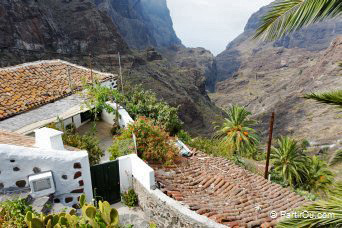
Enclosed between the cliffs of a canyon, the picturesque village of Masca is beautiful! Access to the site is through the secondary road TF436, spectacular because of the many switchbacks that constitutes it. Masca is approximately 600 meters high. After parking his car on the large car park, we can walk the narrow, steep streets of the village overlooking the Barranco de Masca canyon. A fairly difficult trail would go down to the sea through the canyon in about 2 hours (4.5 km).
Garachico
Situated by the sea, the city of Garachico is another site to visit. Its city center is nice and beautiful old churches can be observed. The seaside having no beach, a bathing area was built in the middle of lava rocks.
Orotava
Orotava is a beautiful village with beautiful houses.
Other activities
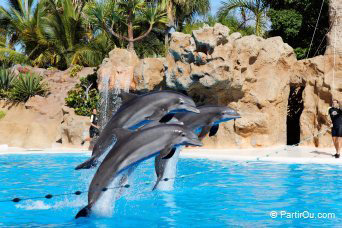
Many water parks exist all over the island, to the delight of young and old! The "Loro Parque" is among the most popular parks; it offers impressive dolphin, orcas and parrots shows. It's also a zoo with animals from all around the world like gorillas or penguins who are sheltered under a huge dome. The park also has a giant aquarium which is crossed via a glass tunnel.
Siam Park is the largest water park in Europe with the largest slide in the world! It is decorated in a "Thai" theme. There are other parks such as Aqualand, Jungle Park, etc
In the evenings, bars and clubs are numerous in all the resorts.
The sea-related activities are also numerous: surfing, windsurfing, kite surfing, parasailing, boating, jet skiing, whale and dolphins watching, diving, etc. ; but do not forget the other possible activities such as paragliding, spa, shopping, visit caves, theater, cinema, entertainment, mountain biking, etc..
When to go?
The climate of the Canary Islands is rather dry throughout the year; it is even very dry during the months of April to September. The temperature is pleasant all year allowing to visit the islands at any time. The hottest months are July, August and September. The trade winds and Atlantic cold currents are responsible for lowering the temperature of the islands. In winter it can happen that it gets 16°C on the coast! At altitude, it can be cold, even very cold with snow everywhere! Swimming in the sea is possible throughout the year, but the water is never very warm, ranging from 18°C in February to 25°C in September. For observation of the exceptional flora on the Teide, including the Red Vipérine Teide (or Tajinaste Rojo in Spanish; plant measuring up to 2-3 m tall that blooms in spring), choose the period April to June.
How to get there?
There are two international airports on the island Tenerife: the Tenerife North (TFN) and the Tenerife South (TFS).
It is also possible to arrive by sea. Generally, you will arrive by boat at the port of Santa Cruz of Tenerife from another Canaries island or continent.
For European citizens, an identity card is sufficient, since the Canary Islands are part of the EU (European Union) and the Schengen Area (free movement of persons).
Several companies share the inter-island ferry trips and boats; among them, the
companies Armas


How to move?
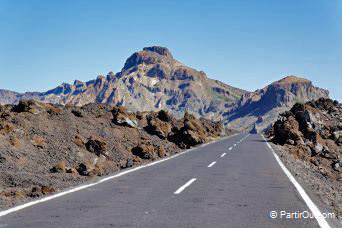
Rented car is certainly the best solution to freely explore the island of Tenerife. Renters are many and most of the major brands are present. You can find a rental car on the spot by going to one of the renters, or by asking your hotel. Very often, the price is more interesting if you book your car before your trip, rather than seeking a rental car on site. Rental prices are very affordable and are around 15 to 20 EUR per day.
Organized tours by bus are frequently offered. To book, refer you simply to an agency on the spot or just to your hotel.
Means of locomotion more expensive: the taxi.
The road network makes it easy to tour the island. The TF21 road (or C821) through the interior of the island from north to south, passing close to the peak of the Teide. It rises to nearly 2400 m above sea level and is truly spectacular! Two other routes can reach the center of the island and Mount Teide: the TF38 (or C823) and TF24 (or C824), both beautiful!
Where to sleep? Where to eat?
Hotel offer is important and often cheap. Take either a half-board or full board is often more interesting than dinner outside his hotel. The formula apartment / hotel is also widespread on the island; you can buy your food at the supermarket (many) and be able to make your own kitchen (which reduces costs). The rates of a hotel room or apartment start at around 20 EUR per night, but can quickly increase depending on the number of stars. It is also possible to stay at the inhabitant (pension), but this type of accommodation is not very common on the island. The best price / quality ratio will remain a room in a hotel or apartment / hotel in the many resorts.
To discover all the hotels and other accommodation:
To know
Money
The Canary Islands are part of the Eurozone, so the currency effect on the islands is the Euro. There will be no problem to make withdrawals or payments with credit cards and ATMs are plenty on the island.
Cuisine
To discover the typical Canarian cuisine, it is preferable to move away from resorts. Indeed, the restaurants located in areas with high tourist pass are not always the best! Fish is a common food in the dishes in the Canaries. Fish fries are found on many maps. Choose tapas allows drip several dishes of the islands. Papas Arrugadas are small potatoes cooked with their skins in salted water, often accompanied by red sauce (mojo rojo), or green sauce (mojo verde). Don't forget to taste the Barraquito, a coffee beverage.
Jet lag and length of days
The Canary Islands apply the DST change (in summer and winter). In summer, day length is approximately 14h while in winter day length is only about 10am.
Children
The Canary Islands are really child friendly and it's easy to travel there, even with the youngest! There is everything in the shops on the island and playgrounds in cities are very common! Moreover, many hotel facilities offer activities for children (club). But be careful with swimming in the sea because there may be big waves.
Language
As the Canary Islands are attached to Spain, the official language is Spanish. English is also widely spoken in tourist areas.
Here are some English-Spanish translations:
- yes: si
- no: no
- hello: buenos días (ou) hola
- good night: buenas noches
- welcome: bienvenida
- bye: adiós
- thank you: gracias
- you're welcome: de nada
- English: Inglés
- island: isla
- city: ciudad
- airport: aeropuerto
- port: puerto
- beach: playa
- volcano: volcán
- ravine: barranco
- hotel: hotel
- car: auto (or) coche
- restaurant: restaurante
- water: agua
- fish: pescado
- chicken: pollo
- rice: arroz
- beer: cerveza
- one: uno
- two: dos
- three: tres
- four: cuatro
- five: cinco
More information...
Discover all our pictures of the Tenerife Island.
We hope to have given you the wish to explore this beautiful destination!
Emmanuelle and Gilles
